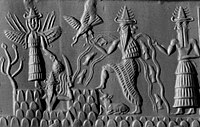Nergal: Difference between revisions
Extended confirmed users 18,533 edits inserting necessary citation to reliable source to support identification of the god in relief as Nergal |
Rescuing 2 sources and tagging 0 as dead. #IABot (v1.6.1) (Balon Greyjoy) |
||
| Line 63: | Line 63: | ||
* [http://oracc.museum.upenn.edu/amgg/listofdeities/nergal/ Ancient Mesopotamian Gods and Goddesses: Nergal (god)] |
* [http://oracc.museum.upenn.edu/amgg/listofdeities/nergal/ Ancient Mesopotamian Gods and Goddesses: Nergal (god)] |
||
* ETCSL "A hymn to Nergal" and "A ''tigi'' to Nergal": [http://www-etcsl.orient.ox.ac.uk/cgi-bin/etcsl.cgi?text=c.4.15*# Unicode] and [http://www-etcsl.orient.ox.ac.uk/cgi-bin/etcsl.cgi?text=c.4.15*&charenc=j# ASCII] |
* ETCSL "A hymn to Nergal" and "A ''tigi'' to Nergal": [http://www-etcsl.orient.ox.ac.uk/cgi-bin/etcsl.cgi?text=c.4.15*# Unicode] and [http://www-etcsl.orient.ox.ac.uk/cgi-bin/etcsl.cgi?text=c.4.15*&charenc=j# ASCII] |
||
* Ereskigal.net – "Ereshkigal and Nergal": [http://www.mindwidth.com/ereshkigal/index.php?ID=1009&cat=3 Assyrian version] and [http://www.mindwidth.com/ereshkigal/index.php?ID=1010&cat=3 Amarna version] |
* Ereskigal.net – "Ereshkigal and Nergal": [https://web.archive.org/web/20050422212706/http://www.mindwidth.com/ereshkigal/index.php?ID=1009&cat=3 Assyrian version] and [https://web.archive.org/web/20050308042708/http://www.mindwidth.com/ereshkigal/index.php?ID=1010&cat=3 Amarna version] |
||
* [http://www.gatewaystobabylon.com/myths/texts/classic/ereshner1.htm Gateway to Babylon: Nergal and Ereshkigal] |
* [http://www.gatewaystobabylon.com/myths/texts/classic/ereshner1.htm Gateway to Babylon: Nergal and Ereshkigal] |
||
Revision as of 08:25, 6 December 2017
| Nergal | |
|---|---|
God of Irkalla | |
| Personal information | |
| Parents | Enlil and Ninlil |
| Siblings | Nanna and Ninurta |
| Consort | Ereshkigal (according to some myths) |
Nergal, Nirgal, or Nirgali (
Nergal is mentioned in the
Attributes

| Part of a series on |
| Ancient Mesopotamian religion |
|---|
 |
|
|
Nergal seems to be in part a solar deity, sometimes identified with Shamash, but only representative of a certain phase of the sun. Portrayed in hymns and myths as a god of war and pestilence, Nergal seems to represent the sun of noontime and of the summer solstice that brings destruction, high summer being the dead season in the Mesopotamian annual cycle. He has also been called "the king of sunset".[5] Over time Nergal developed from a war god to a god of the underworld.[6] In the mythology, this occurred when Enlil and Ninlil gave him the underworld.[5]
Nergal was also the deity who presides over the
Ordinarily Nergal pairs with his consort Laz. Standard iconography pictured Nergal as a lion, and boundary-stone monuments symbolise him with a mace surmounted by the head of a lion.
Nergal's fiery aspect appears in names or epithets such as Lugalgira,
In the late
Nergal's chief temple at Cuthah bore the name Meslam, from which the god receives the designation of Meslamtaeda or Meslamtaea, "the one that rises up from Meslam". The name Meslamtaeda/Meslamtaea indeed is found as early as the list of gods from Fara while the name Nergal only begins to appear in the
The
In demonology
Because he was a god of fire, the desert, and the
See also
- Hades
- Aplu
- Mamitu
- Mars
- Mot
- Odin
- Pazuzu
- Set
- Tyr
- Ghosts in Mesopotamian religions
References
- )
- ^ Borger R. (2004), Mesopotamisches Zeichenlexikon, Münster, p.402
- ^ Clarke's Commentary on the Bible - 2 Kings 17:30
- ^ Dictionary of phrase and fable: giving the derivation, source, or origin of common phrases, allusions, and words that have a tale to tell - Ebenezer Cobham Brewer - 1900 - p268 [1]
- ^ a b Zolyomi, Gabor (2010). "Hymns to Ninisina and Nergal on the Tablets Ash 1911.235 and Ni 9672" in Your Praise Is Sweet: A Memorial Volume for Jeremy Black from Students, Colleagues, and Friends. London: British Institute for the Study of Iraq. pp. 413–428.
- ^ Munnich, Maciej M. (2013). The God Resheph in the Ancient Near East. Tubingen, Germany: Mohr Siebeck. pp. 62–63.
- ^ [2] Encyclopædia of Religion and Ethics, Volume 6 – edited by James Hastings, John Alexander Selbie, Louis Herbert Gray – p.645
- ^ [3] David's Secret Demons: Messiah, Murderer, Traitor, King by Baruch Halpern – p.334 Reference 1
- This article incorporates text from a publication now in the public domain: Chisholm, Hugh, ed. (1911). "Nergal". Encyclopædia Britannica (11th ed.). Cambridge University Press.
External links
- Ancient Mesopotamian Gods and Goddesses: Nergal (god)
- ETCSL "A hymn to Nergal" and "A tigi to Nergal": Unicode and ASCII
- Ereskigal.net – "Ereshkigal and Nergal": Assyrian version and Amarna version
- Gateway to Babylon: Nergal and Ereshkigal

